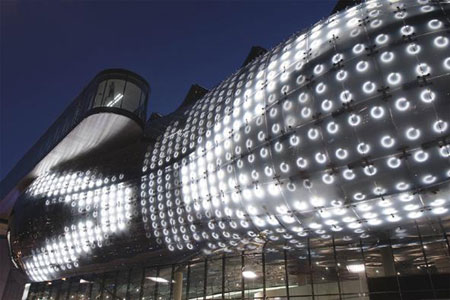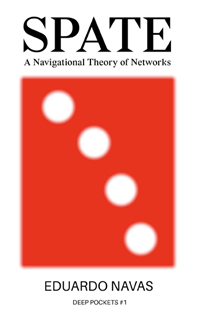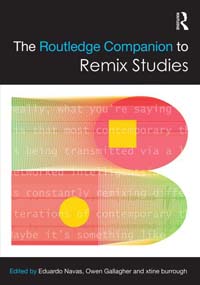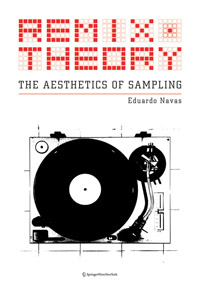Reclaiming the Centre by Marc Boutin

Image source: Mobel Und Wohnen
Text source: evds.ucalgary.ca
Date: Unknown
“The new frame of reference – unlike that of postmodernism and deconstructivism – will no longer be dictated by the unique, the authentic or the specific, but by the universal.”1
It is hard to imagine anyone uttering these words a mere five years ago. In fact, in North America, it can be argued that architectural discourse during the last decade was substantially preoccupied with work defined by the particular, the authentic, and the site-specific. But it was only little more than thirty years ago that the great cultural monolith of modernism began to erode, making way for the pluralistic onslaught of postmodernism. And since that time, our schools of architecture, periodicals, and then cities have witnessed the rise and then demise of historicist postmodernism, deconstructivism, and presently our latest infatuation with authenticity and its tectonic and place-making manifestations.
Although we are familiar with the architects and projects Ibelings is referencing when he uses the term universal, including the Swiss firm Herzog & de Meuron, the Austrian firm of Reigler Riewe, and Abalos and Herreros of Spain, the foundation of this new universality is less understood. Do we understand this work as a reaction against the uniqueness and specificity of the postmodern aesthetic agenda, or is it, as some may suggest, a reaffirmation of modernism’s own polemical universality?
In Alan Colquhoun’s seminal essay Symbolic and Literal Aspects of Technology (1967), he explored the relationship between modern architecture and technology. It was this very relationship that the pioneers of modern architecture had used to distance modern architecture from the perceived inadequacies of the revivalist styles, and secure modern architecture’s claim to the Zeitgeist of the modern world through an ontological argument. In this claim, the ideology of modern architecture dictated that the necessary autonomy of architecture required an idealization of technology and its role in the anticipation of a new utopian society. Modern forms, then, emerged “naturally” from the new technologies of the modern world.
However, Colquhoun surmised that “the new technology was an idea rather than a fact. It became part of [modern architecture’s] content as a work of art and not merely or principally a means to its construction.”2 Therefore, a distinction existed between technology and meaning in modern architecture. In other words, modern architecture’s form and expression did not have a causal relationship to technology but, as other styles before it, were derived from a subjective will to form. The result of this interpretation was an undoing of the ontological argument posited by the early protagonists of the modern movement. As soon as modernism was reconceived as a pure language, without its legitimization through technology, it became susceptible to the same treatment as other languages.
Perhaps the most illustrative example of modern architecture’s manipulation as a language was Peter Eisenman’s work from the early 1970s. In his paradigmatic House series, Eisenman erased the burden of modern architecture’s professed moral, ethical, social, and technological foundations and instead developed essays in architectural semiotics. Based in no small part to the contribution of theorists like Noam Chomsky, Geoffery Broadbent and George Baird, this work was one factor in the beginning of the postmodern critique of and reaction to modernism.
Although the fate of modernism in the subsequent thirty years was its destabilizing and dismantling, it is important to note that for all its assumed failure, the genesis of modern architecture, the technological paradigm, is an inheritance from modernism that is still with us today. This is so because modernism proposed a reconciliation between culture and an emerging technological condition. The Deutsche Werkbund, beginning in 1907, was arguably the first concerted effort towards this reconciliation in an attempt to recuperate meaning and form within a mechanical paradigm. However, this critical and indeed essential engagement with technology was lost in the formalizations of late modernism and the reactionary postmodern critique, with technology becoming perceived as a burden to form-making.
This was in part due to the fact that the postmodern philosophical framework did not allow a conceptualization of modern technology. In general, postmodernism’s strategy of inclusivity propagated marginal and/or practices external to architecture, resulting in a cultural discipline that was self-referential. This self-referentiality displaced the locus of architectural meaning from those aspects of architecture that are central to its material presence, that is light, material, structure, and technique. For example, historicist postmodern architecture advocated pre-modern craft, or elevated the representation of the signs and symbols of pre-modern architecture without any substantial relationship to structure, materiality or spatial implications. As another postmodern strategy, deconstructivism sought to undermine rationality, including technology, and as a result posited fragmented and irrational paradigms, including technological ones, as its leitmotif. And finally, the move to architectural “authenticity”3 advocated craft as a means of resistance, distancing “making” from conventional building practices and inadvertently privileging the part over the whole, and the detail over issues related to space.
From this context arose the work Ibelings refers to under the banner of Supermodernism. And if it is the work’s universality that distinguishes it from the various manifestations of postmodernism, then this work can be said to emerge from at least two conditions. In their own Zeitgeist-inspired genesis, many architects of this work will suggest the importance of globalism as a constituent factor in the emergence of their sensibility. In this context, where a multi-cultural social and political order is emerging and defining our social relationships and cities, the idea of an architecture based exclusively of the signs and symbols of western culture is highly questionable. Consequently, meaning in architecture is sought outside the semiotic and invested more squarely on the material practices of architecture. That is, on those elements that are central to the architectural experience and its material presence: light, material, structure, and space. A new basis for meaning exists in this architecture that is understood as universal. Speaking on his own firm’s work, Jacques Herzog states that they “try to expose materials as clearly and simply as possible, without narration, without any other intention than placing them in front.”4 In this manner, materials are used in a way that “everybody can understand, a kind of global language.”5 In its definition as a new universality addressing the global paradigms of our contemporary culture, this architecture also can be interpreted as a reaction to the profusion of signs, symbols and images of postmodernism, and that architecture’s emphasis on the unique and the particular.
This second condition in the conception of this new work, although different from its relationship to globalism, should also be clarified as an extension of the emerging contemporary Zeitgeist. As a point of illustration, this recent phenomenon has definite parallels to Adolf Loos’s argument against the excesses of the Seccessionists at the turn of the last century. Allan Janik and Stephen Toulmin described Loos’s reaction in their 1973 book Wittgenstein’s Vienna, stating:
Decoration was applied to everything from beer mugs to doorknobs. In this, Loos perceived a mixture of fact and fantasy that was highly detrimental to both. The principles of designing objects for use should be purely factual and determined by the functions that the objects are to serve.6
Translated into the realm of architecture, this position advocated that the design of a building should not refer to something outside of itself, but its forms and expression ought to be reflective of its own logic and use, including its experience. The importance of experience in this new work, as a means of defining an alternative locus for meaning to postmodernism’s semiotic tendency, invites a second comparison to the rise of minimal art in the 1960s. From his essay “Space-Text as Context”, Otto Kapfinger suggests that:
An analogy may be made with minimal art, which was originally conceived in opposition to the subjectivism of art and the visual greed of society in the 1960s. Artists such as Carl Andre, Frank Stella, Dan Flavin, Robert Morris and Donald Judd sought to counteract the values of a highly industrialized society. As an anecdote to the pictorial overload and fragmentation of pop culture, they introduced into art simple values related directly to the human body. Rejecting all that was narrative or symbolic, mimetic or fetishistic, they proposed to strip away the content of the art object in order to show that its meaning was ultimately constructed by the perception of the viewer.7
Because minimalism advocated an object of non-reference, the resultant neutrality induced an experiential state rather than a representational string of meanings. As suggested by Rosalind Krauss, minimalism in itself, by denying private expression due to its “zero degree” form, derived meaning constructed from public space, as opposed to private space.8 In what was perceived to be a crisis of representation, minimalism, in its ability to present rather than represent, or in its sensed meaning rather than an intellectual one, became an alternative strategy to the semiotic recombination and collage symptomatic of postmodern representational malaise.
The apparent characteristics of the new work appear to be in opposition to the inclusivity of sources advocated by postmodernism. The intention is instead an inclusivity of experience through the reinvestment in issues not on the margins of architecture, but central to its material presence. Here, material, light, structure, and technique are orchestrated in the creation of atmosphere that appeals to all five senses, and an open-endedness that, like minimalism, engages the viewer. Critical to the creation of atmosphere, the new work shares minimalism’s penchant for the simple and the neutral, elevating spatial and material effect through a strategy of formal reduction. In describing the interrelationship between this neutrality and experiential richness, Ibelings states that “[o]ne explanation for [the richness of simplicity] might be that an architecture that refers to nothing outside itself and makes no appeal to the intellect, automatically prioritizes direct experience, the sensory experience of space, material and light.”9 And so, in the new work’s use of abstract and simple forms, in its elevation of the sensed over the intellectual, and in its derivation from the central issues of architecture, it manifests a non-pictorial architecture, a poetry without narrative, and modernism without positivism.
Given these characteristics of the new work, it is impossible not to reflect on the debt owed to Mies van der Rohe’s oeuvre. And perhaps more importantly, a comparison between the contemporary work of Herzog & de Meuron and Mies van der Rohe begins to summarize one interpretation of the foundation for an architecture of direct experience. In the designs of both architects, the fundamental inquiry resides in the search for meaning within architecture’s central and constitutional elements: light, material, structure, and space. For Mies van der Rohe, this search was focused through Bauen or building, whereby an architectural spirituality emerged from within architecture’s materiality, construction, and space. In his Chicago period during the 1940s, this quest explored the architectural potentials of the steel frame. As perhaps the most illustrative building of this time, Crown Hall at the Illinois Institute of Technology in Chicago (1956) depicts a steel structure conditioned by a sublime refinement of proportion and space. And in its simple column-free plan, the relationship of served to service spaces, and the modulation of light and utilization through the use of both transparent and translucent glass, it is surely comfortable with the contemporary pronouncements of the architects developing the new work.
Likewise, Herzog and de Meuron’s dismissal of borrowed practices and applied theory in favour of manifesting architecture and experience through primary investigations into the nature of materials and their relationship to site conditions, light, and perception, surely reflects a sensitivity towards the concept of Bauen. It is difficult not to draw a parallel between the way Crown Hall and Herzog & de Meuron’s Ricola Europe Factory (Mulhouse-Brunnstatt, Fance, 1992-1993) engage their respective sites through a formal neutrality. For example, the end concrete walls of the Ricola building act as a repository of the patterning formed by the changing climate and seasons. This passing of time is evidenced through the manner in which the concrete is stained by the rainwater collected on the roof and subsequently allowed to seep over the walls. Time is measured in the architecture. Similarly, the translucent glazing of Crown Hall, attuned to the height of its occupants inside, accepts the shadows projected by the exterior landscape as a subtle and poetic reconnection to the outside – a screen onto which the passing of the sun and the seasons are fleetingly recorded. From the outside the same glass screen captures moments in time as the building’s occupants shift positions relative to the glass resulting in the syncopation of a building’s life unfolding before a witness’ eyes. Both examples are subtleties framed by the explicit formal simplicity of the architecture. As Ibeling suggests, it is:
A form of meaning that is derived directly from how the architecture looks, how it is used, and above all, how it is experienced. After postmodernist and deconstructivist architecture, which appealed primarily to the intellect, a new architecture is evolving which now attaches greater importance to visual, spatial and tactile sensation.10
It would seem that, given the comparison between the two buildings and, by extension, two eras, Ibeling’s statement requires qualification. For although “a new architecture is evolving,” its newness is a relative one given only the context of postmodernism. That the new architecture can be considered both a reaction to this context, and also reflective of an emerging global condition, doesn’t deny a larger and equally important historical lineage – an architectural lineage based on the prioritization of direct experience derived within the concept of Bauen.xt
Notes
1 Hans Ibelings, Supermodernism: Architecture in the Age of Globalism, (Rotterdam: Nai Publishers, 1998), p. 135.
2 Alan Colquhoun, “Symbolic and Literal Aspects of Technology.” Essays in Architectural Criticism: Modern Architecture and Historicism, (Cambridge: MIT Press, 1981), p. 28.
3 The use of this term implies a very general architectural sensibility developed by such theorists as Michael Benedikt and Kenneth Frampton among many others, and influenced by the work of architects like Carlo Scarpa, and Alvar Aalto. Within this sensibility is the articulation of an architecture of resistance- resistance to the homogenizing effects of contemporary society including, but not exclusive to, technology. My contention with this sensibility within the context of this discussion is not in its theory or intentions, but in the indirect manner in which it privileges an architecture and an architectural design process outside of conventional architectural practice. In so doing, it exacerbates the postmodern symptom of marginal architectural practice.
4 Jacques Herzog, interview published at www.forbo-krommenie.com, p.1.
5 Ibid, p. 1.
6 A. Janik and S. Toulmin, Wittgenstein’s Vienna, (New York: Simon and Schuster, 1973), p. 99.
7 Otto Kapfinger, “Space-Text as Context.” Beyond the Minimal, (London: AA Publications, 1998), p. 7.
8 Rosalind Krauss, “The Double Negatice: A New Syntax for Sculpture.” Passages in Modern Sculpture, ( Cambridge: MIT Press, 1977).
9 Hans Ibelings, Supermodernism: Architecture in the Age of Globalism, (Rotterdam: Nai Publishers, 1998) pp. 89, 94.
10 Ibid, p.133.
[Marc Boutin is an Assistant Professor of Architecture in the Faculty of Environmental Design at the University of Calgary, the Supervising Editor of In Situ, and the principal of Marc Boutin Architect.]
Lascia un commento
You must be logged in to post a comment.








